The nature of gravity was obscure to early watchers of the sky who believed that the earth was flat and stationary with the sun, moon, planets and stars moving around it. The idea that the earth was a spinning sphere revolving around the sun began to gain slow acceptance after Nicholas Copernicus of Poland drew attention to the concept in 1543.
In 1582 with the financial support of King Frederick II of Denmark, Tycho Brahe built the best equipped observatory of his day and for three decades carried out very accurate and complete measurements of the positions of stars and planets. Subsequently, Brahe's observations were analyzed by Johannes Kepler from Germany who deduced from them that the orbits of the planets, although approximately circular, are actually ellipses with the sun at one focus.
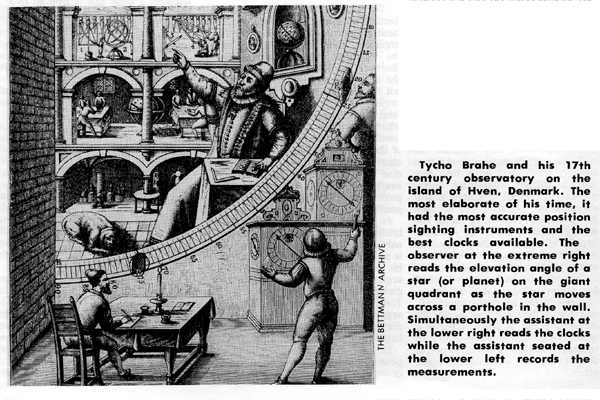
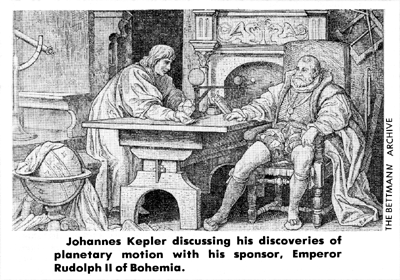
The foundations had been laid and in 1687 Isaac Newton of Cambridge University, England, enunciated his famous Law of Universal Gravitation describing the force of gravity or attraction between two objects, such as the sun and a planet. According to Newton's law, the two objects are attracted by a force that increases in proportion to the product of their masses and decreases in proportion to the square of the distance between them.1(1. Gravitational force=GMM'/R2 where M and M' are the two masses, R is the distance between them and G is the universal gravitational constant.) Newton's derivation of the law depended in a crucial way on Kepler's deductions about planetary motions based on Tycho Brahe's observations. Not only is it a law for planetary motions but also one which tells us, for example, that the force holding an astronaut to the moon is 1/6 that on the earth, or in other words, that the astronaut weighs only 1/6 as much on the moon.
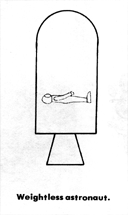
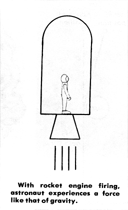 To answer the question, "What is gravity?" it is essential to appreciate that gravity and acceleration are equivalent. Consider an astronaut floating weightless in a space craft. He fires a rocket on the craft causing it to accelerate and immediately he finds himself being pressed to the rocket end of the craft. Rising to his feet he can stand firmly on the floor over the rocket engine. If the acceleration is sufficient to make his weight the same as when standing on the earth, it is said that the acceleration amounts to 1 g (that is, it is equal to the force of gravity at the earth's surface). With all portholes closed and communication with the outside cut off there is no experiment the astronaut can perform inside his craft that would tell him whether he is moving in space or parked on the launching pad on the earth. Acceleration and gravity are equivalent.
To answer the question, "What is gravity?" it is essential to appreciate that gravity and acceleration are equivalent. Consider an astronaut floating weightless in a space craft. He fires a rocket on the craft causing it to accelerate and immediately he finds himself being pressed to the rocket end of the craft. Rising to his feet he can stand firmly on the floor over the rocket engine. If the acceleration is sufficient to make his weight the same as when standing on the earth, it is said that the acceleration amounts to 1 g (that is, it is equal to the force of gravity at the earth's surface). With all portholes closed and communication with the outside cut off there is no experiment the astronaut can perform inside his craft that would tell him whether he is moving in space or parked on the launching pad on the earth. Acceleration and gravity are equivalent.
If the force of gravity can be replaced by an acceleration, then, according to Einstein, it cannot be like the force exerted by a bulldozer. Instead it must represent a special property of 4-dimensional space (3 coordinate dimensions plus time) in which the gravitational effect of a mass is equivalent to a curvature of the space.
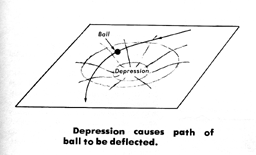
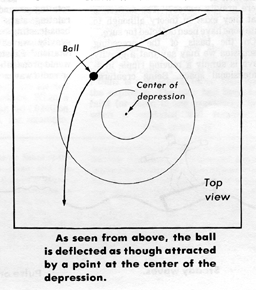 By analogy consider a ball rolling on a plate having a slight depression. As the ball enters the depression its path is bent inward. Looking at the plate from above, and being unaware of the depression, we might think that the ball was attracted by a point at the center of the depression. Thus, Einstein could look at gravity as a space curvature.
By analogy consider a ball rolling on a plate having a slight depression. As the ball enters the depression its path is bent inward. Looking at the plate from above, and being unaware of the depression, we might think that the ball was attracted by a point at the center of the depression. Thus, Einstein could look at gravity as a space curvature.
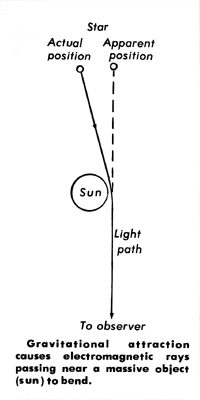 Now if space is curved near a massive body, such as the sun, Einstein concluded that electromagnetic rays, following the shortest path from a star to the earth, would be bent if they passed near the sun or other celestial body. Observations have been performed at both optical and radio wavelengths indicating that this is indeed the case. In effect one can see behind a massive body. Around a black hole, space is curved or curled to such an extent that electromagnetic waves are trapped by it.
Now if space is curved near a massive body, such as the sun, Einstein concluded that electromagnetic rays, following the shortest path from a star to the earth, would be bent if they passed near the sun or other celestial body. Observations have been performed at both optical and radio wavelengths indicating that this is indeed the case. In effect one can see behind a massive body. Around a black hole, space is curved or curled to such an extent that electromagnetic waves are trapped by it.
Another question we may ask is, "Are there gravity waves?" The answer is that they exist in theory although to date none have been detected for sure.
On the basis of the preceding discussion we may say that a gravity wave is simply a moving ripple in 4-dimensional space. Being creatures accustomed to a 3-dimensional world it is difficult to visualize a 4-dimensional space so we resort to analogies. The analogy here would be that of a ball on a taut flexible sheet rippled by a wave traversing it. The ball would be accelerated first one way and then the other as the ripples pass by causing the ball to oscillate back and forth.
Gravity waves of considerable strength could be produced by two stars rotating around each other. The co-rotating stars form a gravitational broadcasting station beating out gravity waves in rhythm to their rotation.2(2. See "ABCs of Space," COSMIC SEARCH, vol. 2, no. 1, Winter, 1980, page 28; "Our Cosmic Universe" by John Kraus, Cygnus-Quasar Books, 1980, page 211. The most complete reference on gravity, gravity waves etc. is the 1279 page book "Gravitation" by Charles W. Misner, Kip Thorne and John A. Wheeler, W.H. Freeman and Co., 1971.) Einstein assumed the waves would propagate with the speed of light or radio waves (300,000 kilometers per second) but this has yet to be verified experimentally.
Gravitational energy may also be radiated when a star collapses into a neutron star (pulsar) or a black hole. In this case the principal radiation would probably be in a short pulse and not in sustained, steady waves as for the co-rotating stars. By analogy a man rocking a boat sends out steady waves but a stone dropped in a pond produces only a few waves, a pulse, which spreads out in a ring. Gravity waves would carry valuable information about star collapses, explosions and other violent events in the universe.

![[NAAPO Logo]](../../Images/NAAPOsm.jpg)
![[NAAPO Logo]](../../Images/NAAPOsm.jpg)